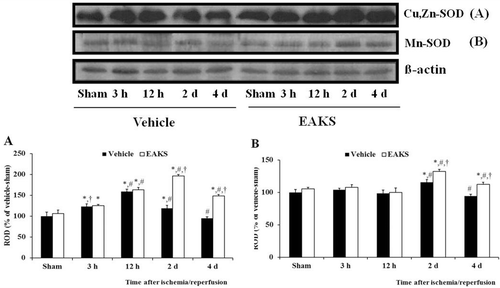Figures & data
Figure 1. NeuN immunohistochemistry in the CA1 region of the sham (A, B), vehicle-ischemia (C, D), 25 mg/kg EAKS-ischemia (E, F) and 50 mg/kg EAKS-ischemia (G, H) groups at 4 days postischemia. In the vehicle-ischemia and 25 mg/kg EAKS-ischemia groups, NeuN-positive neurons (asterisk) are rare in the CA1 region (arrow). However, with the 50 mg/kg EAKS-ischemic group, NeuN-positive neurons are abundant in the CA1 region. SO, stratum oriens; SP, stratum pyramidale; SR, stratum radiatum. Scale bar = 50 µm. G: Relative analysis in the number of NeuN-positive neurons in each group 4 days postischemia (n = 7 per group; *P < 0.05, significantly different from the vehicle-ischemia group). The bars indicate the means ± SEM.
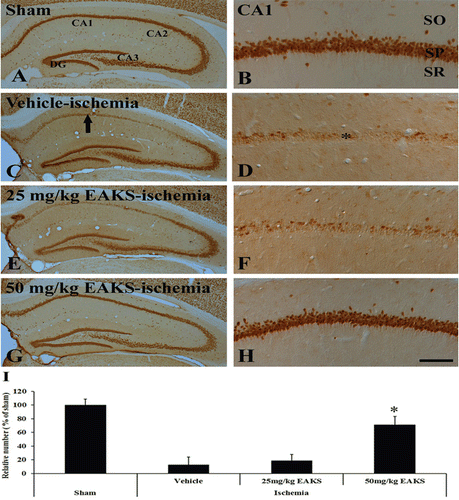
Table 1. Semi-quantifications of 8-OHdG immunoreactivity in the CA1 region in the vehicle-ischemia and 50 mg/kg EAKS-ischemia groups.
Figure 2. Immunohistochemistry for 8-OHdG in the CA1 region in the vehicle-ischemia (A, C, E, G, I) and 50 mg/kg EAKS-ischemia (B, D, F, H, J) groups at sham (A, B), 3 h (C, D), 12 h (E, F), 2 days (G, H) and 4 days (I, J) postischemia. Weak 8-OHdG immunoreactivity is detected in the stratum pyramidale (SP, asterisk) of the CA1 region of the vehicle-sham group. In the vehicle-ischemia group, the immunoreactivity is increased at 3 h postischemia (asterisk) and highest at 12 h postischemia: At this time point, 8-OHdG immunoreactivity is expressed in non-pyramidal cells (arrows). Thereafter, 8-OHdG immunoreactivity is decreased with time after ischemia/reperfusion. In the EAKS-ischemia group, 8-OHdG immunoreactivity is not markedly changed compared to the sham group. SO, stratum oriens; SR, stratum radiatum. Scale bar = 50 µm.
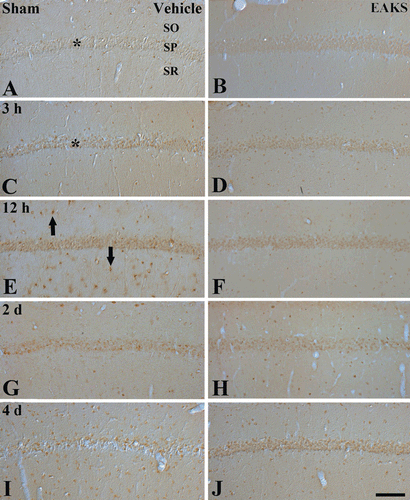
Table 2. Semi-quantifications of HNE immunoreactivity in the CA1 region in the vehicle-ischemia and 50 mg/kg EAKS-ischemia groups.
Figure 3. HNE immunohistochemistry in the CA1 region in the vehicle-ischemia (A, C, E, G, I) and 50 mg/kg EAKS-ischemia (B, D, F, H, J) groups at sham (A, B), 3 h (C, D), 12 h (E, F), 2 days (G, H) and 4 days (I, J) postischemia. In the vehicle-sham group, weak HNE immunoreactivity is detected in the stratum pyramidale (SP, asterisk). In the vehicle-ischemia group, HNE immunoreactivity is increased at 3 h (asterisk) and highest at 12 h (asterisk) postischemia. Four days after ischemia/reperfusion, HNE immunoreactivity in the SP (asterisk) is very low. However, in the EAKS-ischemia group, HNE immunoreactivity is not markedly changed compared to the sham group. SO, stratum oriens; SR, stratum radiatum. Scale bar = 50 µm.
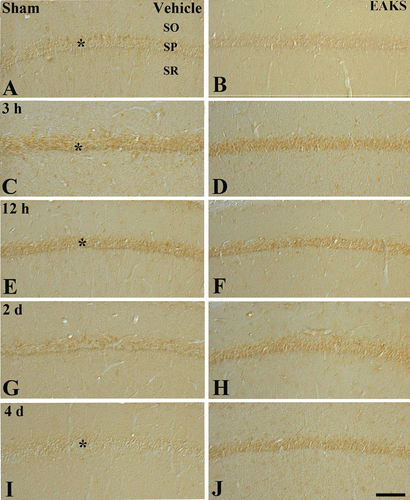
Figure 4. Immunohistochemical staining for Cu,Zn-SOD in the CA1 region in the vehicle-ischemia (A, C, E, G, I) and 50 mg/kg EAKS-ischemia (B, D, F, H, J) groups at sham (A, B), 3 h (C, D), 12 h (E, F), 2 days (G, H) and 4 days (I, J) postischemia. Cu,Zn-SOD immunoreactivity is well detected in the stratum pyramidale (SP, asterisk) in the sham group. In the vehicle-ischemia group, the immunoreactivity is increased (asterisk) at 12 h postischemia, and decreased at 2 days postischemia. Four days after ischemia/reperfusion, Cu,Zn-SOD immunoreactivity in the SP is very low, and Cu,Zn-SOD immunoreactivity is expressed in non-pyramidal cells (arrows). In the EAKS-sham group, Cu,Zn-SOD immunoreactivity is similar to the vehicle-sham group; however, in the EAKS-ischemia group, Cu,Zn-SOD immunoreactivity (asterisk) is much higher than the vehicle-ischemia group. SO, stratum oriens; SR, stratum radiatum. Scale bar = 50 µm.
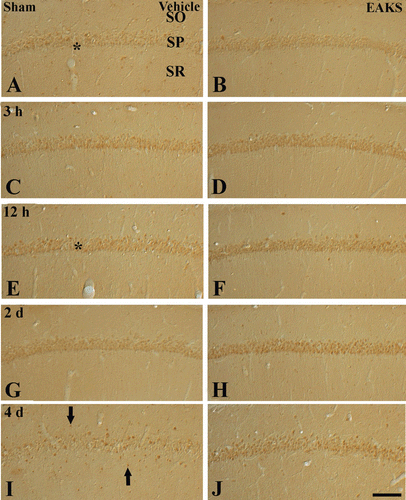
Figure 5. Mn-SOD immunohistochemistry in the CA1 region in the vehicle-ischemia (A, C, E, G, I) and 50 mg/kg EAKS-ischemia (B, D, F, H, J) groups at sham (A, B), 3 h (C, D), 12 h (E, F), 2 days (G, H) and 4 days (I, J) postischemia. Weak Mn-SOD immunoreactivity is found in the stratum pyramidale (SP, asterisk) in the sham group. In the vehicle-ischemia group, the immunoreactivity is not changed by 12 h postischemia; however, at 2 days postischemia, Mn-SOD immunoreactivity is slightly increased in the SP (asterisk). Four days after ischemia/reperfusion, Mn-SOD immunoreactivity in the SP is very low; however, Mn-SOD immunoreactivity is increased in non-pyramidal cells (arrows). In the EAKS-sham and ischemia group, Mn-SOD immunoreactivity is similar to the vehicle-sham and ischemia group; at 2 days postischemia, the immunoreactivity (asterisk) is much higher than the vehicle-ischemia group. SO, stratum oriens; SR, stratum radiatum. Scale bar = 50 µm.
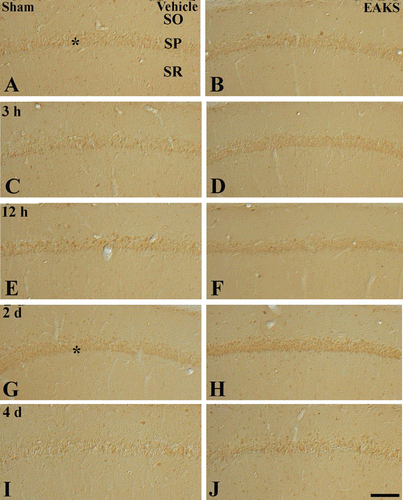
Figure 6. Western blot analysis of Cu,Zn-SOD (A) and Mn-SOD (B) levels in the CA1 region of the vehicle- and EAKS-ischemia group. Relative optical density (ROD) as percentage of the immunoblot band is represented (n = 5 per group; *P < 0.05, significantly different from the vehicle-sham group, #P < 0.05, significantly different from the preceding group, †P < 0.05, significantly different from the vehicle-ischemia group). Bars indicate mean ± SEM.
